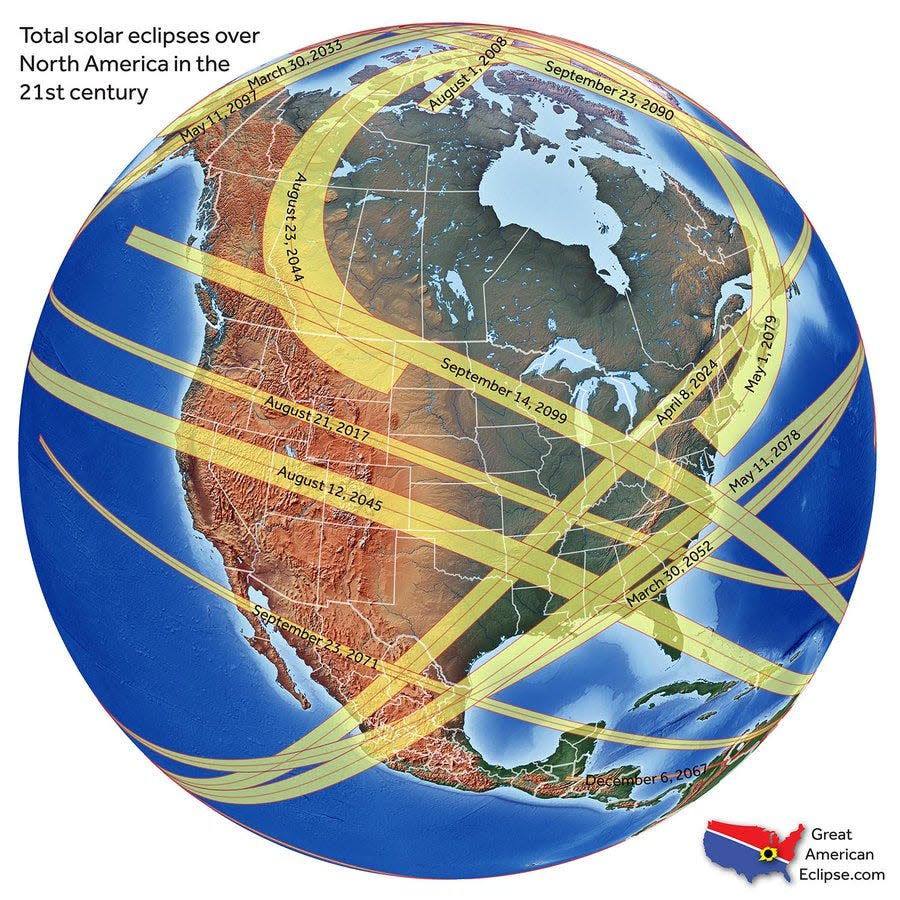Wisconsin isn't on the total path of the next solar eclipse in 2044 but here's when it will be
Yesterday afternoon, people across the country donned their protective glasses and stepped outside to witness a rare total or partial solar eclipse.
Here in Milwaukee, the moon covered about 90% of the sun at the partial eclipse's peak and brought overcast skies, which some observers described as making the world look like an "Instagram filter" and others said was like "wearing sunglasses without actually wearing sunglasses."
Eclipse watchers of all ages caught the astronomical event from the Milwaukee Public Museum, UW-Milwaukee Student Union bridge, outside of their offices and on their balconies. Many told the Journal Sentinel it was their first time watching a solar eclipse.
Naturally, with the much-anticipated 2024 eclipse now over, many people are left wondering when the next one will occur. Here's what to know.

When is the next total solar eclipse in the U.S.?
The next total solar eclipse visible from the continental United States will not occur for another 20 years. More specifically, it will be here on Aug. 23, 2044. However, only three states ― Montana, North Dakota and South Dakota ― will be on its path of totality.
According to NationalEclipse.com, many Western and Midwestern states, including parts of northwestern Wisconsin, will see a partial eclipse during this event. However, the partial eclipse will not be visible from Milwaukee.
Thankfully though, you won't have to wait another 20 years for the next eclipse. Less than a year later on Aug. 12, 2045, another one will grace the skies. Its path of totality will touch South America, the Caribbean and 15 U.S. states from California to Georgia, NationalEclipse.com says.
Wisconsin and most of the Midwest will again see a partial eclipse. In Milwaukee, the moon will cover just over two-thirds of the sun at the 2045 eclipse's peak.
One state, Alaska, will see a total solar eclipse a little sooner on March 30, 2033. However, only part of western Alaska and a small portion of Russia are on the path of totality.

When is the next total solar eclipse in Wisconsin?
Wisconsin has not been on an eclipse's path of totality since 1954 ... and it won't be again until the end of the 21st century. So, if you long to experience totality's stunning effects, your best bet may be to travel to another state in two decades, as many Wisconsinites did for the 2024 and 2017 eclipses.
However, if you're young or lucky enough to live to see Sept. 14, 2099, you'll be able to experience totality from Wisconsin. Milwaukee and much of the rest of the Midwest, including parts of Minnesota, northern Illinois, northeastern Indiana, southwestern Michigan and much of Ohio, will be on the path of the 2099 eclipse, according to NASA.
When is the next total solar eclipse in the world?
The world's next total solar eclipse will occur on Aug. 12, 2026. However, the United States is not on its path of totality. The path includes parts of Russia, Greenland, Iceland and Spain. A partial eclipse will be visible from much of Europe, with France, Portugal and the United Kingdom experiencing over 90% peak coverage.
Replay: 2024 solar eclipse in Milwaukee, Wisconsin, highlights from historic celestial event
This article originally appeared on Milwaukee Journal Sentinel: When are the next total solar eclipses in the US, Wisconsin and the world?
